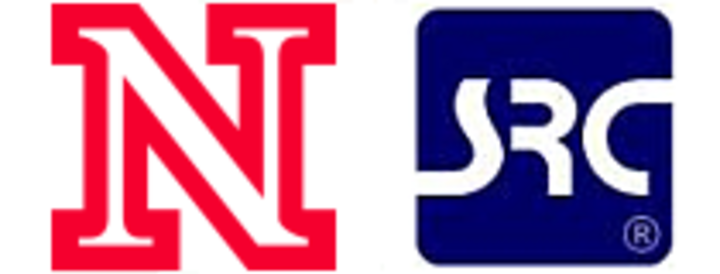SRC/NSF Supplement to Nebraska MRSEC:
The objective of this project is to understand the physics of boundary magnetization of magnetoelectric antiferromagnets by focusing on a range of complex magnetoelectric transition-metal oxides based on corundum and rutile lattices, to evaluate the potential of these materials for electrical magnetization switching, and to search for new magnetoelectric phases with higher Néel temperatures for reliable room-temperature operation. This is a coordinated effort in theory and materials fabrication and characterization to grow the magnetoelectric films and exchange-bias heterostructures, predict and measure their properties, understand the mechanisms of formation of the boundary magnetization and its coupling to proximate films, and assess the novel functionalities of interest for memory and logic applications.
MRSEC Supplement Research Areas:
The International Technology Roadmap for Semiconductors (ITRS) predicts that the scaling of CMOS technology will continue until 2020 [1]. The grand challenge is to invent and develop a new technology to extend the scaling through multiple generations beyond 2020. One of the key challenges is to develop a switch involving a significant bi-stable effect that can be controlled by external stimulus and is robust enough to be harnessed as manufacturable technology. Very active research in the past several years has been focused on the use of magnetization M as a state variable that could be switched electrically, through the application of an electrical voltage, but without generating large currents and hence energy dissipation. Multiferroic materials, which combine magnetic and ferroelectric order parameters in one phase, have been considered as primary candidates [2-6], but, in spite of extensive research, global electric switching of M remains elusive.
Magnetoelectric materials are antiferromagnets (AFM) which develop magnetization as a response to an applied electric field or electric polarization as a response to an applied magnetic field [7-8]. Their free energy is allowed by symmetry to contain products of electric and magnetic field components. Since this imposes strict restrictions on the magnetic point group [9], only a handful of compounds are known to be magnetoelectric, and just a few of them have reasonably high Néel temperatures TN (Cr2O3 is the most well-known with TN = 307 K). A magnetoelectric AFM can be switched between its two single-domain states by applying both E and B fields at the same time [10]. This procedure can be performed isothermally by overcoming the magnetoelectric coercivity, or by heating the sample above TN and then cooling it down. Thus, the AFM domain state of a magnetoelectric AFM can serve as a switchable computational variable. Binek and Doudin [11] proposed nanoelectronic device architectures utilizing the magnetoelectric active layer. A reversal of exchange bias in a proximate (Co/Pt) multilayer induced by magnetoelectric annealing of Cr2O3 was demonstrated [12].
We have recently demonstrated the feasibility of low-power electrical control of magnetization by utilizing the surface magnetization of magnetoelectric Cr2O3, which is robust against surface roughness [13]. In particular, we have achieved, at room temperature, reversible isothermal switching of the global exchange-bias field in the Pd/Co multilayer deposited on a Cr2O3 single crystal by an application of the reversible E and permanent B fields. Since the surface magnetization is not accompanied by electric depolarizing field and is fully stable, this switching is fully non-volatile. Moreover, theoretical analysis [14] shows that all magnetoelectric antiferromagnets (AFM) in a single-domain state are required by symmetry to have a finite magnetization at their boundary with vacuum or another material even in thermodynamic equilibrium. The physics of this effect, as well as its potential exploitation in electrically switched magnetic nanostructures, is the focus of this project.
1. The International Technology Roadmap for Semiconductors (ITRS), 2008 Edition: “Process Integration, Devices, and Structures”.
2. M. Fiebig, Revival of the magnetoelectric effect, J. Phys. D: Appl. Phys. 38, R123 (2005).
3. W. Eerenstein, N. D. Mathur, and J. F. Scott, Multiferroic and magnetoelectric materials, Nature 442, 759 (2006).
4. S.-W. Cheong, M. Mostovoy, Multiferroics: A magnetic twist for ferroelectricity, Nature Mater. 6, 13 (2007).
5. R. Ramesh and N. A. Spaldin, Multiferroics: Progress and prospects in thin films, Nature Mater. 6, 21 (2007).
6. M. Bibes and A. Barthélémy, Multiferroics: Towards a magnetoelectric memory, Nature Mater. 7, 425 (2008).
7. L. D. Landau and E. M. Lifshitz, Electrodynamics of continuous media (Oxford, Pergamon, 1984).
8. M. Fiebig and N. A. Spaldin, Current trends of the magnetoelectric effect, Eur. Phys. J. B 71, 293 (2009).
9. I. E. Dzyaloshinskii, On the magnetoelectric effect in antiferromagnets, Sov. Phys. JETP 10, 628 (1960).
10. T. J. Martin and J. C. Anderson, Antiferromagnetic domain switching in Cr2O3, IEEE Trans. Mag. 2, 446 (1966).
11. Ch. Binek and B. Doudin, Magnetoelectronics with magnetoelectrics, J. Phys. Condens. Matter 17, L39 (2005).
12. P. Borisov, A. Hochstrat, Xi Chen, W. Kleemann, and Ch. Binek, Magnetoelectric switching of exchange bias, Phys. Rev. Lett. 94, 117203 (2005).
13. Xi He, Yi Wang, Ning Wu, A. Caruso, E. Vescovo, K. D. Belashchenko, P. A. Dowben, and Ch. Binek, Robust isothermal electric control of exchange bias at room temperature, Nature Mater. 9, 579 (2010).
14. K. D. Belashchenko, Equilibrium magnetization at the boundary of a magnetoelectric antiferromagnet, Phys. Rev. Lett. 105, 147204 (2010).
Researchers
Kirill Belashchenko (coordinator) - Electronic structure, transport, magnetism
Christian Binek - Magneto-electric heterostructures, exchange bias, magnetic properties
Peter Dowben - Photoemission and inverse photoemission spectroscopy, surface magnetism
